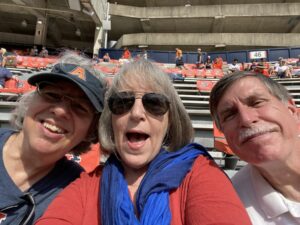Attending college football in the South despite cold agglutinin disease
Temperatures and distances are among the issues I face for my beloved Auburn

“Band! A-tennnnn-hut!”
I watched for the lift of the drum major’s shoulders because the roar of the crowd — in what’s now called Jordan-Hare Stadium, at Auburn University in Alabama — was too loud for anyone in the clarinet section to hear him count off. I double-time marched across the field on the 10-yard line, made a snappy turn, brought my horn up to my lips, and stepped off with the other 270 members of the Auburn University Marching Band (AUMB) as we played “War Eagle,” the school’s battle cry.
In college, I wore myself out on fall weekends with a band member’s activities and responsibilities. To this day, I look forward to Auburn football games. It doesn’t matter if we experience a thrill, like the 2013 Iron Bowl victory, or suffer the ignominy of defeat; it’s still great to be an Auburn Tiger.
But I need more planning to enjoy attending a game now, since I’ve developed cold agglutinin disease (CAD). While I was in college, AUMB players would start the school year with rehearsals five or six days a week before classes. On home games, our Saturdays would begin at 8 in the morning, and we wouldn’t quit playing, marching, and running until around 4 p.m., when we were finally dismissed to go home. That tires out even healthy people.
Although I have the opportunity to relive my former glory as part of the AUMB alumni band, that’s not something I contemplate doing now.
Careful planning reduces symptoms of CAD
One of the main symptoms of CAD is anemia. Anemia equals exhaustion. I wake up in the morning with energy for about 45 minutes. Then I must pace myself. By the end of the morning, I have to rest for several hours.
Although those of us in the alumni band aren’t expected to be as energetic as the college students, I don’t think I could even march into the stadium without difficulties. I even have trouble attending home games as a spectator. But a few arrangements can make game attendance possible for me.
One of the first things I consider is how to get from my parked car to my seat in the stadium. I know that walking is a good exercise, and even those with CAD need some of that. The challenge is that the AU campus is made for pedestrians, and distances from parking lots to the stadium are immense. Because of that, I start early and rest along the way on the many benches or at a table. Sometimes I park at a local mall and ride the shuttle to within a block of the stadium. That way I still have to walk a bit, but less than I would otherwise.
Even in this case, I plan to leave home early. That’s the key.
The second consideration is the weather. Afternoons in central Alabama are typically hot during football season. But for evening games, I must bring a sweater or jacket. I also bring a light scarf to warm my neck and shield my mouth when I breathe. Breathing cold air can trigger hemolysis, which develops into anemia. And it gets cold up in the nosebleed seats, which are usually the ones I can afford.
The jacket also serves a second purpose. The lines waiting for the return buses are long, what with close to 90,000 fans leaving at about the same time. I just don’t have the energy to stand in a line and inch my way with everyone else for about 50 yards to reach the waiting bus.
Instead, I sit on the grass near the bus door and wait until everyone who suffered in the queue has left. I then get on the last bus. While I’m waiting, I sit on the jacket, which helps protect me from the cold ground.
Fun activities are possible when managed
The first game this season kicks off at 2:30 p.m. CDT this Saturday, Sept. 2. If I were attending, I’d leave the house about 9 in the morning. I would park about a city block away from campus and ride in a bicycle cart to the music department’s tailgate tent. There I’d find a place to sit and rest while hearing what my classmates, also returned for the fun, had been doing. From there, I’d just take a leisurely, short-distance stroll to the stadium, getting there in time to see our eagle soar around the field and watch the current AUMB perform their pregame show.
My doctor is not surprised that my blood flows burnt orange and navy blue, the Auburn colors. He’s an Auburn alumnus, too, and has supported the band program. With planning, although I can’t be quite as energetic as I once was, my fun and participation will be as unyielding as they were years ago.
Note: Cold Agglutinin Disease News is strictly a news and information website about the disease. It does not provide medical advice, diagnosis, or treatment. This content is not intended to be a substitute for professional medical advice, diagnosis, or treatment. Always seek the advice of your physician or other qualified health provider with any questions you may have regarding a medical condition. Never disregard professional medical advice or delay in seeking it because of something you have read on this website. The opinions expressed in this column are not those of Cold Agglutinin Disease News or its parent company, Bionews, and are intended to spark discussion about issues pertaining to cold agglutinin disease.








Leave a comment
Fill in the required fields to post. Your email address will not be published.